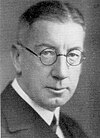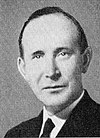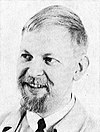Surgeon-General of the Swedish Armed Forces
| Surgeon-General of the Swedish Armed Forces | |
|---|---|
| Försvarsinspektören för hälsa och miljö | |
 Coat of arms of the Surgeon-General. | |
since 20 October 2021 | |
| Swedish Armed Forces | |
| Abbreviation | FIHM |
| Reports to | Supreme Commander of the Swedish Armed Forces[a] |
| Constituting instrument | FIB 2020:5, Chapter 13, 9 § |
| Formation | 1914 |
| First holder | Anton Nettelblad |
The Surgeon-General of the Swedish Armed Forces[2] (Swedish: Generalläkaren, GL, previously Generalfältläkaren, since 2017 called the Försvarsinspektören för hälsa och miljö, FIHM) is the highest-ranking medical officer of the Swedish Armed Forces. The Surgeon-General is responsible for the supervision of the Swedish Armed Forces, the Defence Materiel Administration, the Swedish Fortifications Agency and the National Defence Radio Establishment. This includes supervision in the areas of environment, health, nature, sewage, waste and chemicals.
History
[edit]A surgeon is a doctor who performs surgical operations. The Swedish Army's surgeons were named after their military rank: surgeon-captain, surgeon-major, surgeon-general, closest corresponding to the Swedish överfältläkare ("Surgeon-General"), but not generalfältläkare ("Surgeon-Field General"), because there were several surgeon-generals within the English Army.[3] In Swedish history, physicians were mentioned for the first time in the 16th century. They were educated at medical schools abroad and were employed partly in the service of the court or the rich nobility, and in the military. They lacked a relationship among themselves and were not subordinate to any medical authority. The beginning of an organized medical system was not noticeable until much later. Some practicing physicians in Stockholm received after subservient request permission to form a Collegium medicorum which was privileged by King Charles XI's regency in 1663. From this initially individual circle of physicians, the authority was developed that was given the task of overseeing the state's health and medical care.[4]
The rank Surgeon-Field General (generalfältläkare) existed according to the 1856 instruction of the Swedish Army Medical Corps, but only during war time.[5] In the Swedish Army Medical Corps on 1 January 1915, the following ranks were added; Surgeon-Field General (generalfältläkare) instead of Surgeon-General (överfältläkare), Surgeon-General (överfältläkare) instead of field surgeon (fältläkare) and field surgeon (fältläkare) instead of division surgeon (fördelningsläkare). The Swedish Army Medical Corps consisted in peace time of (except the reserve) 1 Surgeon-Field General (major general), 1 Surgeon-General (colonel, respectively lieutenant colonels), 6 field surgeons (lieutenant colonels), 49 regimental physicians (majors), 55 battalion physicians in military units, hospitals, etc. (captains), 44 battalion physicians in the Swedish Army Medical Corps (captains and lieutenants) and 24 field medical grantees (lieutenants).[6]
The oversight of the entire Swedish medical administration was carried out for the civilian institutions by the National Swedish Board of Health and for the military by the Medical Board of the Royal Swedish Army Materiel Administration (Arméförvaltningens sjukvårdsstyrelse) and the Sanitary Department of the Royal Swedish Naval Materiel Administration (Marinförvaltningens sanitetsavdelning). The Medical Board consisted of a Director-General and Chief, as well as five directors (byråchef), including four doctors and a veterinarian.[4] The Surgeon-Field General was the head of the Healthcare Board of the Royal Swedish Army Materiel Administration and the Surgeon-in-Chief of the Swedish Navy was the head of the Sanitary Department of the Royal Swedish Naval Materiel Administration. These officials were appointed by the King in Council.[4] The Surgeon-Field General was in charge of the medical care management in the field, and was subordinate to the army's highest commander, and the acting Surgeon-Field General was in charge in the hometown.[7]
On 17 December 1943, the title was changed from Surgeon-Field General (generalfältläkare) to Surgeon-General (generalläkare) when acting Surgeon-Field General David Lindsjö was nominated for this office.[8] From 1969, the Surgeon-General was head of the Medical Board of the Swedish Armed Forces and the Medical Corps of the Swedish Armed Forces.[9] Following the Swedish Armed Forces' reorganization in 1998, the Surgeon-General was part of the Joint Operations Command (Operationsledningen, OPL) as head of the Medical Services Department, but was in his capacity as the supervisory authority for the health service, responsible directly to the government.[10]
On 1 April 2007, the Swedish Armed Forces decided that the Surgeon-General would only have a supervisory role. The functional responsibility for health and medical care was transferred from the Surgeon-General to the logistics function within the Armed Forces. Supervision was transferred to a newly started unit at the Swedish Armed Forces Headquarters. The Surgeon-General was given responsibility for this and also maintained the name. The position of Surgeon-General became civilian, but at the corresponding brigadier general level. The focus of the Surgeon-General's work was shifted from the health care area to the environmental area. The supervisory department was given 17 positions.[11] On 1 October 2017, the regulatory agency Generalläkaren changed name to Försvarsinspektören för hälsa och miljö ("Defence Inspector for Health and Environment").[12]
Activities
[edit]The Surgeon-General verifies that the Swedish Armed Forces comply with laws and regulations relating to environmental and health protection, food safety, animal protection, animal welfare, animal health, health and medical care and disease control. In the area of environmental and health protection, the Surgeon-General is also responsible for supervising the activities of the Defence Materiel Administration, the Swedish Fortifications Agency and the National Defence Radio Establishment. Supervision and control involves an independent review of compliance with applicable legislation. Therefore, when the Surgeon-General exercises his supervisory and control function he is not subordinate to the Supreme Commander of the Swedish Armed Forces. Every year, the Surgeon-General carries out about ten inspections and around 400 supervisory and inspection visits to garrisons, units, installations and exercises, both in Sweden and in places where the Swedish Armed Forces operates internationally. The Surgeon-General is appointed by the government. In the Supervisory Department, administrative officers, doctors, nurse, veterinarians, environmental and health protection inspectors, food inspectors, lawyer and department manager work.[13]
Heraldry
[edit]The coat of arms of the Surgeon-General of the Swedish Armed Forces which was also used for the Medical Board of the Swedish Armed Forces from 1943 to 1994. Blazon: "Azure, the lesser coat of arms of Sweden, three open crowns or placed two and one. The shield surmounting a sword bendwise and a rod of Asclepius bendwise sinister in saltire, all or".[14]
List
[edit]| No. | Portrait | Name | Took office | Left office | Time in office | Ref. | |
|---|---|---|---|---|---|---|---|
| Surgeon-Field General (Generalfältläkare) | |||||||
| 1 | Anton Nettelblad, Hon M.D. (1852–1942) | 23 December 1914 | 16 September 1917 | 2 years, 267 days | [15] | ||
| 2 | Fritz Bauer, Hon M.D. (1864–1956) | 1917 | 1930 | 12–13 years | - | ||
| 3 | Richard Erhardt, L.Med. (1876–1961) | 1930 | 1939 | 8–9 years | [16] | ||
| - | David Lindsjö, Hon M.D. (1887–1952) Acting | 14 October 1939 | 1943 | 3–4 years | [17] | ||
| 4 | Oskar Nordlander, L.Med. (1884–1953) | 1943 | 1943 | 0 years | [18] | ||
| Surgeon General (Generalläkare) | |||||||
| 5 | David Lindsjö, Hon M.D. (1887–1952) | 1 January 1944 | 1 October 1952 | 8 years, 274 days | [17] | ||
| 6 | Carl Erik Groth, M.D. (1905–1993) | 1952 | 1964 | 11–12 years | [19] | ||
| 7 | Carl-Johan Clemedson, M.D. (1918–1990) | 1964 | 1974 | 9–10 years | [20] | ||
| 8 | Åke Lindgren, M.D. (1927–2020) | 1975 | 1981 | 5–6 years | [21] | ||
| - | Bo Rybeck, M.D. (1935–2019) Acting | 1979 | 1980 | 0–1 years | [22] | ||
| 9 | Bo Rybeck, M.D. (1935–2019) | 1981 | 1985 | 3–4 years | [22] | ||
| 10 | Rear admiral Björn Zetterström, L.Med. (1937–2011) | 1985 | 1997 | 11–12 years | [23] | ||
| 10 | Major general Ann-Marie Göransson, M.D. (born 1947) | 1 July 1997 | 31 December 2003 | 6–7 years | [24] | ||
| 11 | Brigadier general Sture Andersson, M.D. (born 1950) | 1 January 2004 | 31 December 2006 | 0–1 years | [25] | ||
| - | Colonel Claes Meijer (born 1955) Acting | 2007 | 2007 | 0 years | [26] | ||
| 12 | Brigadier general Siegfried de Joussineau, M.D. (born 1949) | 2008 | 2015 | 6–7 years | [27] | ||
| 13 | Brigadier general Pierre Campenfeldt, M.D. (born 1973) | 1 October 2016 | 30 September 2017 | 364 days | [28] | ||
| Defence Inspector for Health and Environment (Försvarsinspektören för hälsa och miljö) | |||||||
| 13 | Brigadier general Pierre Campenfeldt, M.D. (born 1973) | 1 October 2017 | Incumbent | 8 years, 39 days | [28][29] | ||
See also
[edit]- Surgeon-in-Chief of the Swedish Army
- Surgeon-in-Chief of the Swedish Air Force
- Surgeon-in-Chief of the Swedish Navy
Footnotes
[edit]- ^ The Surgeon-General is directly subordinate to the Supreme Commander of the Swedish Armed Forces in accordance with section 3 of FIB 2020:5. Sections 21 and 21 a of the ordinance (2007:1266) with instructions for the Swedish Armed Forces state that when the Surgeon-General and the Chief of the Safety Inspectorate (Aviation Authority) (Flygsäkerhetsinspektören) exercise their supervisory or control function, the Surgeon-General and the Chief of the Safety Inspectorate (Aviation Authority) are not subordinate to the Supreme Commander.[1]
References
[edit]Notes
[edit]- ^ "Försvarsmaktens interna bestämmelser med arbetsordning för Försvarsmakten (FMArbo) - FIB 2020:5" (PDF). FÖRSVARSMAKTENS INTERNA BESTÄMMELSER (in Swedish). Swedish Armed Forces. 16 December 2020. Retrieved 26 March 2021.
- ^ Gullberg 1977, p. 290
- ^ Westrin 1918, p. 774
- ^ a b c Guinchard 1915, p. 253
- ^ Olsson, Rosén & Westrin 1882, p. 571
- ^ Westrin, Fahlstedt & Söderberg 1923, p. 1127
- ^ Rosén & Westrin 1890, p. 1148
- ^ Rudberg 1944, p. 41
- ^ Sköldenberg 1970, p. 438
- ^ Johansson 1998
- ^ "Tillsyn och kontroll på hälso- och miljöområdet inom försvaret - Statens offentliga utredningar 2015:79" (in Swedish). Stockholm: Riksdag. 2015. Retrieved 22 October 2021.
- ^ "Generalläkaren blir Försvarsinspektören". www.miljosamverkanstockholm.se (in Swedish). Miljösamverkan Stockholms län. 2 October 2017. Retrieved 11 November 2018.
- ^ "Generalläkaren" [Surgeon-General] (in Swedish). Swedish Armed Forces. Retrieved 13 September 2017.
- ^ Braunstein 2006, p. 14
- ^ Clemenson 1987–1989, p. 550
- ^ Vem är det 1942, p. 222.
- ^ a b Clemenson 1980–1981, p. 595
- ^ Lewenhaupt 1962, p. 152
- ^ Uddling & Paabo 1992, p. 392
- ^ Vem är det 1984, p. 215.
- ^ Vem är det 1984, p. 682.
- ^ a b Salander Mortensen 1996, p. 962
- ^ Salander Mortensen 1996, p. 1235
- ^ Örn 1997, pp. 2612–2613
- ^ "Förlängda förordnanden i Försvarsledningen" (Press release) (in Swedish). Ministry of Defence. 2003-12-18. Retrieved 21 October 2021.
- ^ Henriksson 2008, p. 228
- ^ Spiegelberg 2009, p. 228
- ^ a b "PÅ NY POST" (PDF). Försvarets forum: Personaltidning för fast anställda och reservofficerare i svenska försvarsmakten (in Swedish) (5). Stockholm: Försvarets forum: 8. 2016. SELIBR 4109339.
- ^ "PÅ NY POST" (PDF). Försvarets forum: Personaltidning för fast anställda och reservofficerare i svenska försvarsmakten (in Swedish) (5). Stockholm: Försvarets forum: 9. 2022. SELIBR 4109339.
- Braunstein, Christian (2006). Heraldiska vapen inom det svenska försvaret [Heraldry of the Swedish Armed Forces] (PDF). Skrift / Statens försvarshistoriska museer, 1101-7023 ; 9 (in Swedish). Stockholm: Statens försvarshistoriska museer. ISBN 91-971584-9-6. SELIBR 10099224.
- Clemenson, Carl-Johan Clemenson (1980–1981). "David M Lindsjö". Svenskt biografiskt lexikon (in Swedish). Vol. 23. National Archives of Sweden. Retrieved 21 October 2021.
- Clemenson, Carl-Johan Clemenson (1987–1989). "P Anton V Nettelblad". Svenskt biografiskt lexikon (in Swedish). Vol. 26. National Archives of Sweden. Retrieved 21 October 2021.
- Guinchard, Joseph, ed. (1915). Sveriges land och folk: historisk-statistisk handbok. D. 1 (in Swedish). Stockholm: Norstedt. SELIBR 8075507.
- Gullberg, Ingvar E. (1977). Svensk-engelsk fackordbok för näringsliv, förvaltning, undervisning och forskning [A Swedish-English dictionary of technical terms used in business, industry, administration, education and research] (in Swedish) (2nd ed.). Stockholm: Norstedt. ISBN 91-1-775052-0. SELIBR 8345587.
- Henriksson, Maria, ed. (2008). Sveriges statskalender 2008 (PDF) (in Swedish). Stockholm: Norstedts Juridik AB. ISBN 9789138324059. SELIBR 10900526.
- Lewenhaupt, Sten (1962). Svenska högre ämbetsmän från 1634: högre ämbetsmän och chefer för statliga verk inom central och lokal förvaltning m.m. : namn och årtal (in Swedish). Stockholm: Norstedt. SELIBR 8075040.
- Olsson, B.F.; Rosén, John; Westrin, Theodor, eds. (1882). Nordisk familjebok: konversationslexikon och realencyklopedi innehållande upplysningar och förklaringar om märkvärdiga namn, föremål och begrepp (in Swedish). Vol. 5. Stockholm. SELIBR 78095.
{{cite book}}: CS1 maint: location missing publisher (link) - Rosén, John; Westrin, Theodor, eds. (1890). Nordisk familjebok: konversationslexikon och realencyklopedi innehållande upplysningar och förklaringar om märkvärdiga namn, föremål och begrepp (in Swedish). Vol. 14. Stockholm. SELIBR 78095.
{{cite book}}: CS1 maint: location missing publisher (link) - Rudberg, Erik, ed. (1944). Svenska Dagbladets årsbok TJUGOFÖRSTA ÅRGÅNGEN (Händelserna 1943) [Svenska Dagbladet's Yearbook TWENTY-FIRST VOLUME (Events of 1943)] (in Swedish). Stockholm: Svenska Dagbladet. SELIBR 283647.
- Salander Mortensen, Jill, ed. (1996). Vem är det: svensk biografisk handbok. 1997 [Who is it: Swedish biographical handbook. 1997] (in Swedish). Stockholm: Norstedt. ISBN 91-1-960852-7. SELIBR 3681533.
- Sköldenberg, Bengt, ed. (1970). Sveriges statskalender. 1970 (in Swedish). Uppsala: Fritzes offentliga publikationer.
- Spiegelberg, Christina, ed. (2009). Sveriges statskalender 2009 (PDF) (in Swedish). Stockholm: Norstedts Juridik AB. ISBN 978-9138324646. SELIBR 11452377.
- Uddling, Hans; Paabo, Katrin, eds. (1992). Vem är det: svensk biografisk handbok. 1993 [Who is it: Swedish biographical handbook. 1993] (in Swedish). Stockholm: Norstedt. ISBN 91-1-914072-X. SELIBR 8261513.
- Westrin, Theodor, ed. (1918). Nordisk familjebok: konversationslexikon och realencyklopedi (in Swedish). Vol. 27 (Ny, rev. och rikt ill. uppl. ed.). Stockholm: Nordisk familjeboks förl. SELIBR 8072220.
- Westrin, Theodor; Fahlstedt, Eugène; Söderberg, Verner, eds. (1923). Nordisk familjebok: konversationslexikon och realencyklopedi (in Swedish). Vol. 35 (Ny, rev. och rikt ill. uppl. ed.). Stockholm: Nordisk familjeboks förl. SELIBR 8072220.
- Vem är det: svensk biografisk handbok. 1943 [Who is it: Swedish biographical handbook. 1943] (in Swedish). Stockholm: Norstedt. 1942. SELIBR 10335454.
- Vem är det: svensk biografisk handbok. 1985 [Who is it: Swedish biographical handbook. 1985] (in Swedish). Stockholm: Norstedt. 1984. ISBN 91-1-843222-0. SELIBR 3681527.
- Örn, Peter (1997). "Nya generalläkaren Ann-Marie Göransson: Försvarsmedicinsk forskning måste bli ett prioriterat område". Läkartidningen (in Swedish). 94 (30–31). Stockholm: Sveriges läkarförbund. SELIBR 8257938. Archived from the original on 2017-08-25. Retrieved 2019-10-14.
Journals
[edit]- Johansson, Bengt-Arne (1998). "Det nya Högkvarteret". Vårt försvar: Tidskrift (in Swedish). 109 (3). Stockholm: Allmänna försvarsföreningen. SELIBR 3430365. Retrieved 26 January 2018.
External links
[edit]- Official website (in Swedish)











